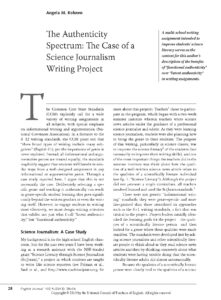Author: Angela Kohnen
Summary: The SciJourn project, in which students learn to write like science reporters, was initially designed to help students develop scientific literacy. However, it became much more — a key to high school students’ engagement as learners, researchers, and writers and their teachers’ opportunity to explore “real world” genre-based writing assignments and assessments. This article provides a rich discussion with specific examples that can guide teachers in developing writing assignments and learning experiences that take into account “functional authenticity.” Those designing professional development, grants, summer institutes, or study groups on topics such as disciplinary literacy, genre, or authentic learning/writing will find ample food for thought!
Original Date of Publication: May 2013
Excerpt
I have begun thinking of the concept of ‘authenticity’ as a spectrum. On one end is ‘latent authenticity’; the genre may exist in the ‘real world,’ but this fact is not highlighted in class either in the teaching of the genre or in the grading of the assignment. Instead, student work is assessed according to teacher goals that are primarily separate from the successful real-world execution of the genre.[…]
On the other end of the authenticity spectrum is ‘functional authenticity.’ Not only does the genre exist outside of school, but the use of it in the classroom draws on the genre’s real-world qualities. Student writing is assessed according to teacher goals and genre goals; in other words, success in the genre (by external criteria) and success in the assignment are one and the same. Our classrooms are not the ‘real world’ (as it is generally defined) and so our writing assignments can never possess total functional authenticity, but we can move toward that end of the spectrum when it makes sense. For SciJourn science teachers, the functional authenticity of the assignment was extremely important. Students in these classes could have written about textbook science topics as if they were ‘news’ stories (basically the science journalism version of my ‘letter to the editor’ assignment), but students wouldn’t have had to consider the dynamic nature of the field, wade through the varying opinions that exist about contemporary science topics, or choose topics that were truly relevant and interesting. Making the assignment functionally authentic demanded that students approach the writing as reporters, not just as students proving that they read a piece of text.[…]
But ‘real world writing’ includes a great many genres; what the notion of functional authenticity also forces us to consider is the differences between these genres—both in our instruction and in our assessment. Really teaching genres, and determining how to assess them, requires that we think about more than just what the genre looks like on the page (or screen), but also what the genre requires of the writer.
Related Resources
- Composing Science (NWP Radio)
- Getting Real: Authenticity in Writing Prompts
- Why Science Teachers Should Write
- The Boise State Writing Project’s Science Pathway
- Linking Genre to Standards and Equity
Original Source: National Writing Project, https://www.nwp.org/cs/public/print/resource/4537
